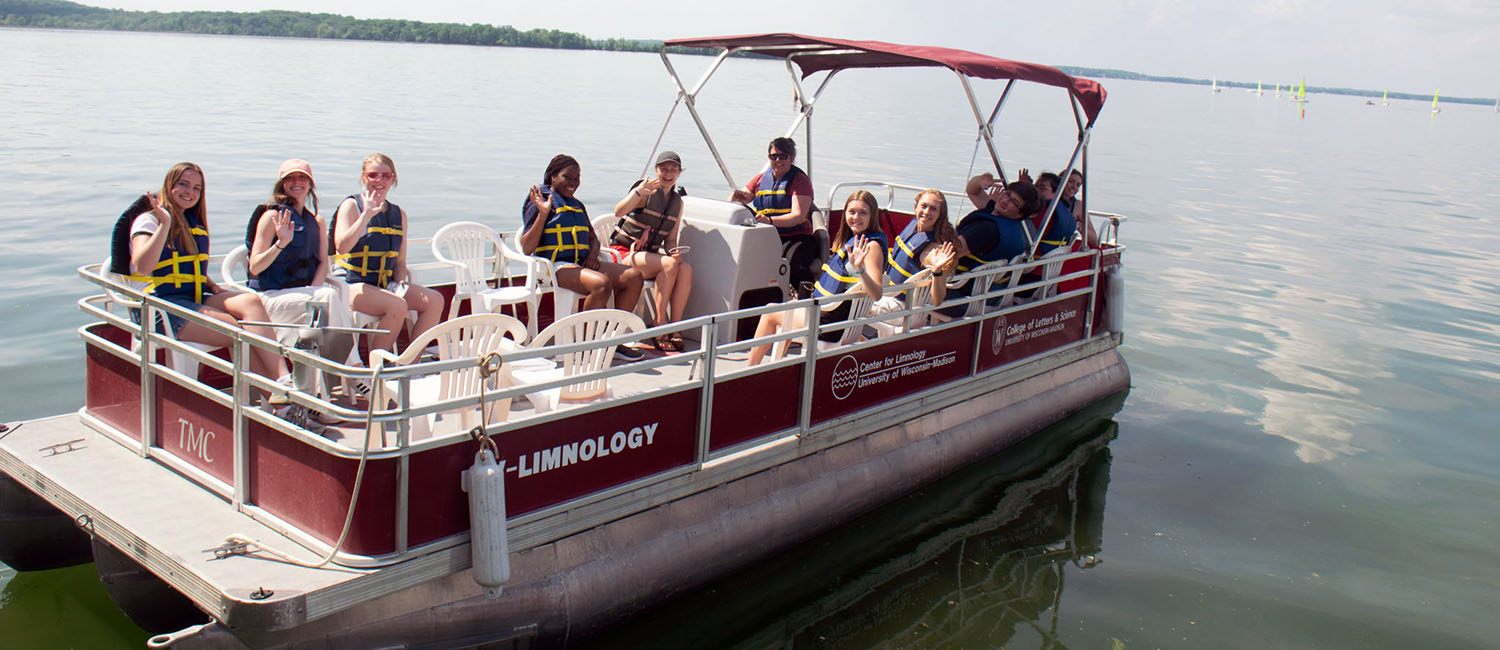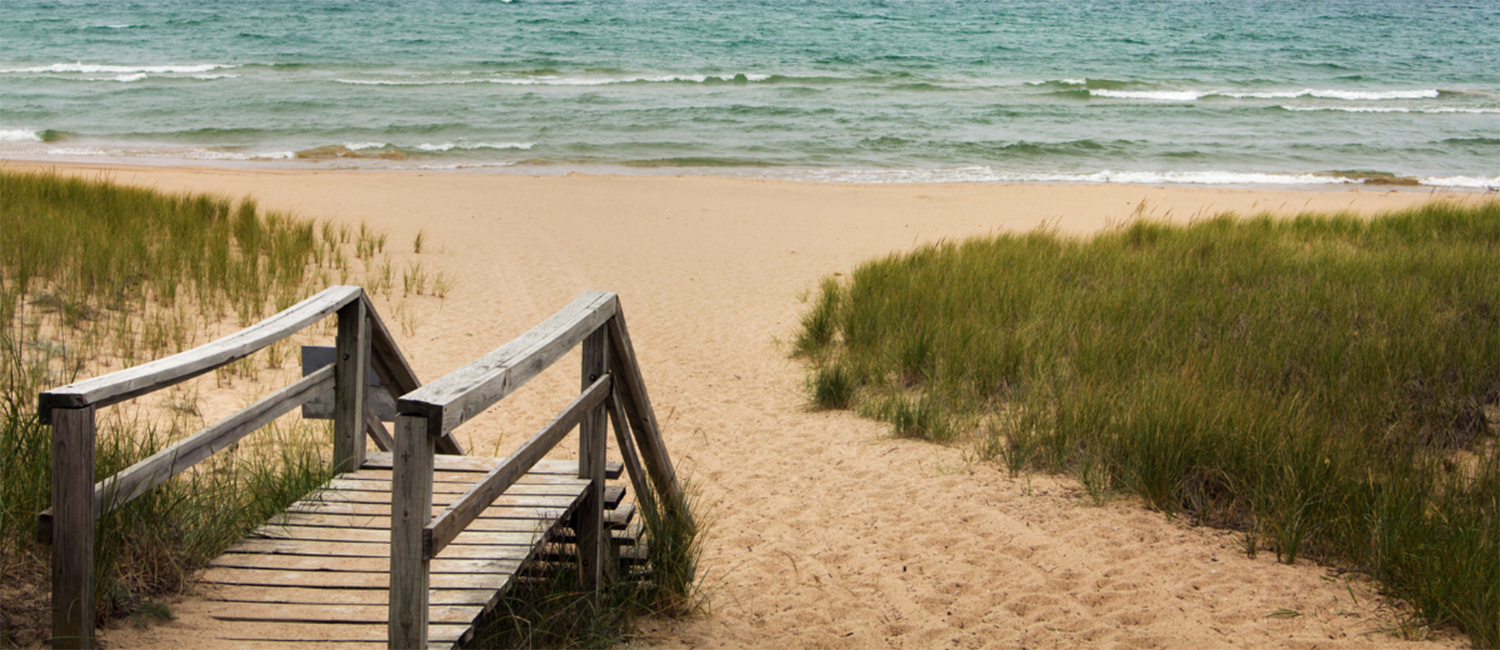Author: Heidi Jeter
2023 Freshwater@UW Summer Research Scholars Program
By Moira Harrington,
UW-Madison/Wisconsin Sea Grant
When summer stretches before many college undergraduates, they make plans: Spend time outdoors. Connect with friends. Catch up on screen time.
For the 31 undergraduates participating in the 2023 Freshwater@UW Summer Research Scholars Program, those plans are the same, with slight alterations. The time outdoors is likely to be spent collecting field samples from a body of water. The friends are new ones—made from the pool of program participants who hail from California to Alabama from Virginia to Wisconsin, and points in between. The screen time isn’t about beating The Legend of Zelda: Tears of the Kingdom, but instead entering findings into a larger dataset to further aquatic science projects.
“I looked at many summer REU (research experiences for undergraduates) opportunities,” Sofia Mota Chichy, chemistry major from the University of Michigan, said. “This one at Madison had the most in water chemistry and that’s what I am interested in. I’ve never worked in a chemistry lab before and it’s even better that it is an aquatic one.” Mota Chichy will be a part of University of Wisconsin-Madison’s Christine Remucal’s lab studying magnesium oxide.
A second young woman also expressed her attraction to this opportunity because of its emphasis on water. Plus, said Jessica Alcorn a student at Northwest Missouri State, “I want to go to graduate school here in Madison.” She’ll work under UW-Madison’s Matt Ginder-Vogel, who does both surface and groundwater research.
These springboards from research to a new path in life were celebrated by an enthusiastic Marissa Jablonski at a recent orientation session for the students. “Life will form you without you trying. You’re on your way. You’ve shown up. You’re leaning in.”
Jablonski is the executive director of the Freshwater Collaborative of Wisconsin, one of the funding entities for the summer program, about which, Sea Grant Director Jim Hurley said, “It’s been really positive to be able to expand our program because of support from the Freshwater Collaborative. Last year, we were a fledgling program of nine students.” Hurley secured a nearly $358,300 grant from the collaborative, resulting in this year’s larger cohort.
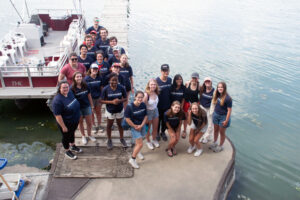 No matter the size of the group, though, Hurley said the goal remains unchanged, “The overall goal is to provide immersive student research experiences to enhance workforce development skills and allow undergraduates to consider the option of graduate studies in Wisconsin. Research experience as an undergraduate is an important component of a successful application for graduate school. In the job market, it also sets apart recent undergraduates who have addressed the changing needs of water-related fields.”
No matter the size of the group, though, Hurley said the goal remains unchanged, “The overall goal is to provide immersive student research experiences to enhance workforce development skills and allow undergraduates to consider the option of graduate studies in Wisconsin. Research experience as an undergraduate is an important component of a successful application for graduate school. In the job market, it also sets apart recent undergraduates who have addressed the changing needs of water-related fields.”
Expanding the number of participating students is one thing, another is the broadened involvement from professors, graduate students and others at organizations that are acting as mentors for the students. There are 48 in all, including people on University of Wisconsin System campuses in Eau Claire, Green Bay, La Crosse, Madison, Milwaukee and Oshkosh. Also providing formative experiences will be mentors from the U.S. Geological Survey, the Lake Superior National Estuarine Research Reserve, Wisconsin Shipwreck Coast National Marine Sanctuary and Wisconsin Maritime Museum.
In application materials, students this summer expressed interest in pursuing research into topics such as pollution, climate change, molecular structures of water, public health and more. The projects will deliver on that skill-building, spawning a new generation of water leaders. While the students will disperse across the state for these labs and field sites, they have a standing invitation to gather each Thursday virtually—and in-person if they are in Madison—for weekly professional development sessions on topics like science communication, navigating graduate school and proposal writing.
They will add these skills to their already prodigious ones in other areas that demonstrate well-rounded natures. At the orientation session, Alison Mikulyuk, summer research opportunity program coordinator, called out fun facts when she said among the group there was a proficient loon caller, a mushroom finder, dancers, an aspiring author, someone who graduated from high school as a 14-year-old, a boxer, world-medalist baton twirler, two twins, competitive swimmers, a multi-instrumentalist, many who play instruments and several who speak more than one language.
Mikulyuk urged the undergraduates to enjoy those skills of others, and also capitalize on the people who possess them, “Learn from each other. Care for each other…Take advantage of personal and professional connections.” She continued, “I hope you will have a life-changing experience that propels you forward in your next decades.”
The program will run until Aug. 5, culminating in a poster session where students will present their summer’s worth of findings.
In addition to the Freshwater Collaborative of Wisconsin and Sea Grant, the summer program has support from the University of Wisconsin Water Resources Institute, Water@UW Madison and the UW-Madison Graduate School.
Great Lakes Beach Association Conference Abstracts Due June 30
Join us at the 21st Annual Great Lakes Beach Association Conference on October 16-18 in Sturgeon Bay, Wisconsin. This year’s conference is hosted by the University of Wisconsin, Wisconsin’s Department of Natural Resources, with the Great Lakes Beach Association.
Marissa Jablonski, Freshwater Collaborative’s executive director, will provide the keynote address. In order to make the meeting as affordable as possible for students, student registration of $25 has been supported by the Freshwater Collaborative of Wisconsin.
The deadline for abstracts for posters and oral presentations is June 30. The focus areas for this year’s conference are:
- Laboratory Technologies/Rapid Detection Methods
- Harmful Algal Blooms in the Great Lakes
- Microbial Mitigation Strategies & Case Studies
- Microbial Source Tracking & Risk-Based Decision Making
- Beach Safety & Beach Notification Systems
- Trash Mitigation & Microplastics in the Great Lakes
- Community Science and Public Engagement
National Wildlife Federation Student Innovative Policy Memo Contest Deadline June 30
National Wildlife Federation is excited to offer awards that recognize undergraduate or graduate students over the age of 18 who develop innovative recommendations for state and local policies that can help improve water quality and/or the resilience of communities to flooding through nature-based approaches. Nature-based solutions include conserving and restoring natural ecosystems, such as healthy wetlands, floodplains, and forests, as well as employing engineered systems designed to mimic natural system functions. The area of geographic interest is the Mississippi River mainstem states including overlapping Tribal and Indigenous lands and waters (Minnesota, Wisconsin, Iowa, Illinois, Missouri, Kentucky, Tennessee, Arkansas, Mississippi, and Louisiana).
Award: 1st Prize: $5,000; 2nd Prize: $2,500; 3rd Prize: $1,000. Winners will be announced in July 2023. Winners also may have an opportunity to present their idea virtually to National Wildlife Federation staff and could have their ideas developed into policy platforms.
Details at: NWF Student Memo Competition 2023
NWF Policy Memo Contest Official Rules 5-22-23
How to Apply:
- Memo must be between 800-1000 words, not including references.
- Entries must be submitted by email in .pdf or .doc form, and may only be submitted once.
- Submit entries by email to KnuffmanL@nwf.org by June 30th, 2023.
Steering Committee Meeting, May 31
The Freshwater Collaborative Steering Committee will meet Wednesday, May 31 from noon-1 p.m. via Zoom.
Agenda:
- Certificate Planning Update
- Legislative Funding Strategy Update
- FCW Program Priorities and Process
- Private Partnership Networking Event Planning
- GLHEC Symposium
https://uwm-edu.zoom.us/j/6521525400
Password: FCW
Ag-Water Nexus field trip explores water challenges, solutions in Southwest Wisconsin
Written by Alison Parkins, UW-Platteville
The University of Wisconsin-Platteville recently hosted students from across the state for the second Wisconsin Agriculture-Water Nexus Network field trip, funded by the Freshwater Collaborative of Wisconsin, where students explored critical issues related to the connections between agriculture and water management.
The three-day field trip course was developed last year by faculty from UW-Platteville, UW-Madison, UW-Green Bay and UW-Stevens Point. The host of the field trip rotates to leverage the regional geographic variations of each participating school.
“The main goal of the trip is to expose students to different regions of the state and how the farmers and researchers are addressing water quality issues there,” said Dr. Joseph Sanford, assistant professor in the School of Agriculture and organizer of the recent trip. “Southwest Wisconsin presents some pretty unique issues. The landscape of agriculture production is much different.”
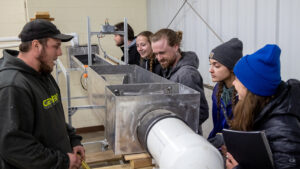
Some of the challenges, unique to Southwest Wisconsin, Sanford explained include the topography of the Driftless region, which leads to more runoff in the fields. The soil in the region is siltier, making it more highly erodible than the sandy soil of Central Wisconsin. The popularity of trout fishing in the region poses additional challenges because of the close proximity of streams to agricultural land.
“The majority of the trip was spent talking about efforts that researchers and producers are putting into trying to reduce impact, mainly focused on surface water,” said Sanford. “The main goal was to get students in the field seeing these issues. As professors, we hear from people at the DNR, UW-Extension or NRCS, that water quality is a huge issue – related to agriculture – and when our students come out of programs focused on water quality or environmental science, they know the issues, but they don’t always know the production side. They have to be able to step on a farm and talk to the producer, and that’s a different game. So, we want to expose them to water quality issues but also expose them to different types of agriculture and different types of producers.”
The three-day field trip included visits to small and large farming operations, including the Cates Family Farm in Spring Green, Wisconsin, and the Wilson Organic Farm in Cuba City, Wisconsin, where they learned about their regenerative grazing practices and other ways they are committed to conservation on their land. Students learned about cover crops, tillage practices and other land-water management methods through meetings with the NRCS, the Lafayette Ag Stewardship Alliance and Yahara Pride Farms and visits to UW-Platteville’s Pioneer Farm, the Lancaster Agriculture Research Station and the USDA Dairy Forage Site, among others.

“Before this trip, I had no experience with agriculture production but a little experience with water quality issues,” said Emma Ball, a senior from Elburn, Illinois, majoring in environmental engineering. “I wanted to participate in this experience, because water quality problems in varying settings and land uses interested me. I wanted to see how serious water quality impacts were taken in the agriculture realm and in southwestern Wisconsin.”
Ball was one of 16 students who participated; six students from UW-Platteville were joined by students from UW-River Falls, UW-Stevens Point and UW-Green Bay. Students represented a range of programs, from soil and crop science, reclamation, environment and conservation, and environmental engineering.
Jeffrey Smolinski, a soil and crop science major, joined the trip in order to gain more context around concepts he learned in class.
“I worked with Dr. Sanford in an internship before and have had many classes based on water quality or agricultural production, so I have plenty of background information on those topics,” said Smolinski, a junior from New London, Wisconsin. “What made me desire going on the trip was to put that book knowledge into real-life observations of operations and do on-site tours. Revisiting what you know through various approaches significantly helps learning and recollection, and this trip did exactly that.”
Sanford said plans are underway to continue offering the field trip at least once a year, in different regions of the state, and the long-term goal is to encourage students to participate again and expand their knowledge beyond Southwest Wisconsin.
“Students in Platteville aren’t necessarily going to stay in Platteville, just like students in Green Bay aren’t necessarily going to stay there,” he said. “Being exposed to these different areas is really going to broaden students’ opinions, in the long-term, about how systems are managed. The overall goal of the group is to try to expose students to the different ways farmers manage their farms and the different ways that farmers – along with researchers, extension agents and whoever else is on the ground – are helping to address these water quality issues.”
It’s that coordination and collaboration among everyone working to solve these issues that Maggie Foster, a junior reclamation, environment and conservation major, said was her biggest takeaway from the trip.
“In the field, we see farmers working with agronomists, working with lab scientists, working with conservationists, etc.,” said Foster. “The list goes on. Soils and plants run on very complex systems, so it makes sense that there would be extensive systems in place to manage them, so that was very fun to witness firsthand.”
The Wisconsin Agriculture-Water Nexus Network – established with funding from the Freshwater Collaborative of Wisconsin – is a network of water researchers from University of Wisconsin institutions across the state, tasked with developing educational courses on agriculture-water management. For more information about WAW2N, visit freshwaterdev.wisconsin.edu/ag-water-network/.
Water-Quality Monitoring Program Connects Teens to Environment
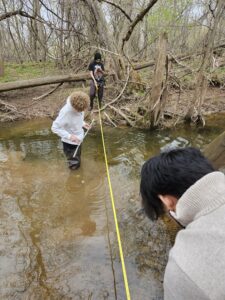
When Dana Lex, a science teacher at West De Pere High School, was approached by UW-Green Bay faculty in 2006 to participate in a new water-quality monitoring program, she jumped at the opportunity to create a course that would get students outdoors.
“I’ve built my environmental science class around this project, and I feel it helps students be better parents, citizens and voters and to know that their future is connected to the health of the environment because they actually have experienced it firsthand,” she says.
UW-Green Bay’s Lower Fox River Watershed Monitoring Program has grown into a network of teachers and students from 11 area high schools and middle schools who monitor environmentally impaired streams in the Fox River watershed for water quality and ecological health.
Student teams collect data that help researchers assess long-term trends and evaluate restoration efforts throughout the watershed. It’s important work that helps measure runoff pollution flowing to the Fox River and Bay of Green Bay where it contributes to the much publicized “dead zone” in the bay.
“Being involved with the program connects students to their environment in ways you cannot replicate any other way. It’s as simple as that,” Lex says. “There are so many careers out there related to environmental health and sustainability is becoming more mainstream every year.”
Participating students present their research findings to students, teachers, UW-Green Bay faculty and staff, and community members at the Annual Watershed Symposium. The 16th annual event in spring 2023 was funded by a grant from the Freshwater Collaborative of Wisconsin and involved about 10 teachers, 65 students and 15 college and community professionals.
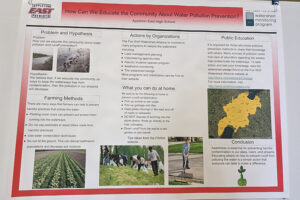
During the symposiums, participants exchange ideas; share research findings through panel discussions, posters and presentations; compare data from their streams; and interact with researchers in water-quality fields. This year they also heard form Anna Qualls, who will graduate from De Pere High School in May 2023. Qualls was the first high school intern to participate in UW-Green-Bay’s Freshwater Summer Scholars Internship Program, which is also supported by the Freshwater Collaborative. (Read about her experience).
“The symposium is a great place to share data and see how our watershed is connected. You get a sense that with enough data and enough voices, we can and will make a difference improving our water resources,” says Mark Valentine, a science teacher at Aldo Leopold Community School in Green Bay.
Valentine joined the program and UW-Green Bay’s Wild Rice in the Classroom program as a first-year teacher two years ago, and 2023 was the first time his eighth-grade students presented their findings from monitoring the Fox River.
“The program provides great hands-on learning opportunities for our students and helps them understand the impacts we have on the water quality here locally,” he says. “It is a wonderful opportunity to get out of the classroom and know that the data we are collecting can have a positive impact.”
Student Spotlight: From DAM Crew to Interns
With a grant from the Freshwater Collaborative of Wisconsin, six undergraduates were selected for the “The Dam Analysis and Monitoring Crew,” a two-week field experience during which they were trained to provide monitoring for a dam removal project in River Falls. The DAM Crew is a cooperative effort involving UW-River Falls, the Kiap-TU-Wish Chapter of Trout Unlimited, the Kinni Corridor Collaborative and Inter-Fluve. Read more at Dam Removal Project Opens Flow of Community-based Training and Research.
Jordyn Curtis and Mckenna Kellogg, Conservation majors at UW-River Falls, have continued work on the project as interns. Here’s what they had to say about their experience.
Why did you participate in this field research?
Curtis: I was in a hydrology course last spring, and I loved the material we were learning. This was an opportunity to get hands-on experience. And I like fishing, and the Kinnickinnic is good for trout fishing!
Kellogg: I also wanted the hands-on experience. I wanted to see what I could do in a future career if I wanted to work with water.
What did you learn?
Curtis: I had only had one water course before the DAM Crew, so I learned a lot about why temperature changes are super important to the trout. I learned how to do geomorphic surveys and why they are important. We looked at the vegetation and what that tells you. As a group we drew out how we thought the stream would meander once the dams were taken out and looked at how that would affect our plans of putting in a trail that everyone could access.
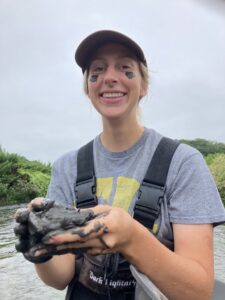
It also helped us work on our teamwork skills. You work on that a bit in school in group projects, but this is very different. It was unique working with a team of 10 to 12 people.
Kellogg: I enjoyed learning about how the geomorphology changed based on where we were located in the river. In the impoundment between the two dams, you have 8-foot-tall clay walls of sediment built up. Sean [Morrison with Inter-Fluve] had us design what we thought the area should look like after the dam is removed. He had so much information about why we couldn’t put certain things in a certain area because in a few years after they’ve done the work, it will change. For example, if we put a kayak launch over here, it will get washed away in two years.
What was the benefit to interacting with different faculty and working professionals?
Kellogg: I really had only experienced what I could through class or if somebody came to campus to talk. Professors have to be more objective and tell you the various ways you could do something, and you have to decide what’s best. Getting in the field, you get to see how people work hands-on in their careers every day. That was interesting and gives you a new perspective on what you want to do with your future.
Curtis: Seeing how the Wisconsin DNR and Trout Unlimited and the Kinni Land Trust all work together was eye opening for me. Kent [Johnson from Trout Unlimited] and Sean gave us a very different point of view than our professors. Sean showed us so many different projects that he’s he worked on, problems he’s had to deal with and what they did. You could see before and after. That was helpful.
You were both hired as interns to continue the project. What have you been doing?
Curtis: We just started, so we’ve been looking at archives of arial photos to see what Lake Louise looked like in 1958 and looking at plot maps to see how things have changed.
Kellogg: What we did during the summer was geomorphology surveys and vegetative cover. We’ll continue to gather more data. We also want to do soil core samples and sedimentation inventory. Jordyn is talking about doing a sedimentation study at the mouth of the river where it meets St. Croix. We kind of have free reign of what we want to research.
I’m very appreciative they gave us the opportunity to continue all the study from the summer. They trust us with this independent research and believe in us to be able to create a framework for future interns. Because we’re at the beginning of this project, we get to lay the groundwork for it to expand. Ten years down the road we’ll get to see what people have done with it.
Curtis: Exactly. We’re pioneers.
What are your career goals and how will this experience help you attain them?
Kellogg: What I love about a conservation degree is that it opens you up to work in pretty much any discipline. I really like what I do now [as a park ranger for the WDNR] and I would like to continue to work for the DNR. I think it could be fun to work in water — maybe aquatic surveying, which would be a fun mix between field studies and data analysis.
Curtis: The DAM Crew and this internship have taught me how to gather, consolidate and use data. Doing vegetation surveys for the DAM Crew this spring will make me better at plant ID, and doing more with the soil will give me more background information for forestry. I have a position with the Forestry Service as a forestry crew technician starting in May in Superior National Forest. That was the best result I could have hoped for.

